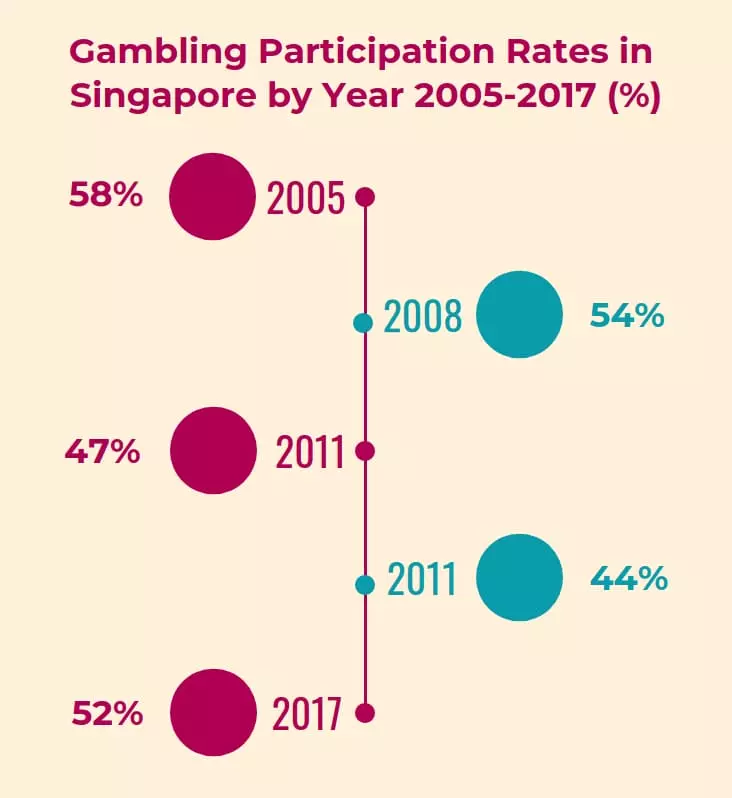 Last week, the National Council of Problem Gambling (NCPG) of Singapore presented its report of gambling participation and problem gambling among local citizens’ in 2017. This was the fifth survey which takes place every three years in the country to monitor the Singapore residents’ participation in gambling activities, with the previous studies being held in 2005, 2008, 2011 and 2014.
Last week, the National Council of Problem Gambling (NCPG) of Singapore presented its report of gambling participation and problem gambling among local citizens’ in 2017. This was the fifth survey which takes place every three years in the country to monitor the Singapore residents’ participation in gambling activities, with the previous studies being held in 2005, 2008, 2011 and 2014.
As revealed by the NCPG, the latest survey on gambling participation of Singapore adults had two major objectives. On one hand, the study was aimed at making an assessment of gambling activities’ extent and pattern among adult citizens of the country. On the other hand, the report is focused on providing more details about gambling addiction among local adult citizens, as well as offering information about problem gambler’s profile.
Gambling Participation and Patterns
 The National Council of Problem Gambling (NCPG) revealed that similar to the 2017 research, the participants to the 2017 survey who had taken part in at least one gambling activity over the last 12 months were described as “gamblers”.
The National Council of Problem Gambling (NCPG) revealed that similar to the 2017 research, the participants to the 2017 survey who had taken part in at least one gambling activity over the last 12 months were described as “gamblers”.
As the latest study on gambling participation revealed, a total of 52% of Singapore adult residents (aged 18 and above) had been classified as gamblers as they had taken part in at least one form of gambling in the pat 12 months. This figure represented an 8% increase from 44% reported in the previous survey in 2014. The increase also put an end to the continuous decline that has been registered in gambling participation since the first survey was carried out in 2005.
2017 Gambling Participation Compared to Previous Years
 At the time when the inaugural survey of Singapore adult gambling participation rates was carried out, the rate was estimated to 58%. The next research registered a 4% decline to 54%. The trend continued further, with 7% down in gambling participation rates to 47% in 2011 and another 3% decline to 44% registered in 2014. The last year’s increase in the number of Singapore adults who have taken part in gambling activities resulted from the increase in Chinese residents’ gambling participation, and thanks to the increased interest toward Toto, 4D and social gambling activities.
At the time when the inaugural survey of Singapore adult gambling participation rates was carried out, the rate was estimated to 58%. The next research registered a 4% decline to 54%. The trend continued further, with 7% down in gambling participation rates to 47% in 2011 and another 3% decline to 44% registered in 2014. The last year’s increase in the number of Singapore adults who have taken part in gambling activities resulted from the increase in Chinese residents’ gambling participation, and thanks to the increased interest toward Toto, 4D and social gambling activities.
As far as demographic groups are concerned, the survey found that certain groups of adults have seen relatively high gambling participation rates.
According to the information provided in the NCPG report, 62% of the Chinese adults who participated in the survey have taken part in at least one gambling activity over the last 12 months. Male Singapore residents were also more involved in gambling than female, with 58% of the respondents being classified as gamblers. In addition, 58% of the gamblers were aged 40 years old and above, with the same gambling participation percentage rate registered among adults with an average monthly personal income in the range from SGD1,000 to SGD1,999.

Preferred Gambling Activities, Betting Amounts and Starting Age
 In terms of preferred gambling activities, the 2017 survey findings were pretty much similar to the ones registered in the previous one, which took place in 2014. It turned out that the most popular type of gambling activity were 4D games, with 42% of the research respondents having preferred to place bets on such an activity. Toto gambling was second, with 36% of Singapore residents having placed wagers on it. The research also showed that 21% of the respondents preferred social gambling options, while other 18% found the Singapore Sweep most attractive.
In terms of preferred gambling activities, the 2017 survey findings were pretty much similar to the ones registered in the previous one, which took place in 2014. It turned out that the most popular type of gambling activity were 4D games, with 42% of the research respondents having preferred to place bets on such an activity. Toto gambling was second, with 36% of Singapore residents having placed wagers on it. The research also showed that 21% of the respondents preferred social gambling options, while other 18% found the Singapore Sweep most attractive.
As far as betting amounts are concerned, the average amount wagered by adult Singapore gamblers on a monthly basis in 2017 was SGD30. In comparison, the average amount spent by local citizens on gambling activities monthly in 2014 was estimated to SGD20. Also, the majority of local citizens (around 58%) betted less than SGD50 monthly, while approximately 91% of the survey respondents betted an amount smaller than SGD200 per month.
The NCPG gambling participation rates report also provided more detailed information about the starting age of gambling activities. According to the data provided by the Council, a total of 74% of the respondents who had ever gambled shared they started to participate in gambling activities before they turned 30. This percentage rate is quite similar to the one reported in 2014. In addition, almost half of the survey respondents in 2017 revealed that they started to regularly take part in gambling activities before the age of 30, with the rate remaining clost to the figures reported in 2014.
Problem Gambling among Singapore Residents
 The National Council of Problem Gambling report also provided some details about probable pathological and problem gamblers rates based on the information gathered by the Council’s survey. The NCPG also explained that pathological gambling represents a more severe form of gambling addiction in comparison to problem gambling behaviour.
The National Council of Problem Gambling report also provided some details about probable pathological and problem gamblers rates based on the information gathered by the Council’s survey. The NCPG also explained that pathological gambling represents a more severe form of gambling addiction in comparison to problem gambling behaviour.
The 2017 survey found that between 0.03% and 0.2% of the research participants may be categorised as probable pathological gamblers. The rate has remained statistically quite similar to the one announced in the 2014 report.
On the other hand, the latest NCPG research provided some data about the number of Singapore adult gamblers that may be classified in the less severe category of probable problem gamblers. According to the results included in the Council’s report, between 0.5% and 1.1% of the survey participants may be categorised as problem gamblers. In comparison to the results at the time previous survey in 2014, the percentage rate of such players amounted to 0.8%.
When it comes to the typical players’ profile, the 2017 survey found that there was slightly higher possibility for male players to become pathological gamblers. Residents of the Chinese demographic group were also more likely to become pathological gamblers, and so were the players aged between 50 and 59 years.
As far as betting amounts among pathological players are concerned, the 2017 survey found that the monthly average spending of such players on gambling activities amounted to approximately SGD250, which is considerably higher compared to the average amount spent by regular gamblers. In addition, according to the survey results, practically all pathological gamblers placed bets frequently (no less than once a week), while the percentage rate of frequent regular gamblers amount to 31%.
Gamblers’ self-control in gambling was also studied by the latest research of the NCPG, with gamblers being asked whether they spent more money they had initially planned to do or played for a longer period of time than they had intended. The report showed that players with poor gambling activities’ self-control had mainly participated in activities, including online gambling, horse racing, jackpot machines and table games.
- Author


